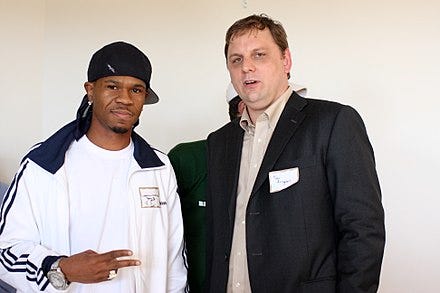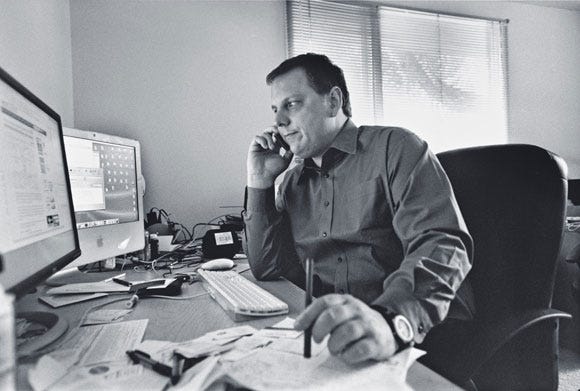📰 Techcrunch
Techcrunch's journey to 100,000 readers?
Hello Friends 👋,
Happy Thursday.
Today, we dissect the early chapters of TechCrunch, the playbook they used to grow a personal blog into a media behemoth.
I am most interested in tackling the following questions: How did they gain credibility? How did they become the voice of authority on everything startup? And, of course, How do they acquire their first readers?
Let’s unravel the origin of this industry linchpin.
Timeline
2005: Techcrunch was founded as a Web 2.0 tracking blog
2006: Hit 50,000 subscribers
2006: Hit 133,000 subscribers & $1.4m in revenue
2007: $3m Revenue
2010: Sold to AOL for $30-$40m with $10m in revenue
Not your typical founder
A native of Southern California, Mr. Arrington majored in economics at Claremont McKenna College and ventured to Silicon Valley to attend Stanford Law School in 1992. He worked for the Wilson Sonsini Goodrich & Rosati law firm before joining Internet startup RealNames Corp. in 1999.
Though RealNames later collapsed and liquidated, this period was significant as it marked the genesis of Mike's close relationship with RealNames founder Keith Teare.
Keith Teare, the former CEO of RealNames, observed that Mr. Arrington is a "very ambitious guy," further noting an evident pattern—Mike hadn't stayed at any job for longer than 18 months over the past ten years. According to Teare, Mr. Arrington is "extremely focused on money. He wants to be rich.”
This mindset perhaps fueled the venture that materialized six years later when Keith and Mike initiated a venture studio-like partnership called Archimedes. Through his early days of building the first company under this partnership, a company called Edgeio, Mike started TechCrunch.
The backstory: riding the tails of Web 2.0
Web 2.0 era
The Web 2.0 era, which emerged in the early 2000s, marked a significant digital shift, reshaping how individuals and businesses interacted online. The internet evolved from a static platform to a dynamic, user-driven environment during this period.
Key hallmarks of the Web 2.0 era included the rise of social media platforms, blogging websites, and e-commerce stores. Web 2.0 transformed how people communicated and introduced new opportunities for businesses to engage with their audiences and market their products and services.
Techcrunch’s founding story
TechCrunch's story began on June 11, 2005.
Techcrunch was Mike’s personal blog dedicated to chronicling interesting companies in Web 2.0.
At the same, Mike was embarking on his own Web 2.0 venture studio(ish) adventure alongside Keith Teare. They eyed the boundless horizon of building Web 2.0 enterprises.
The venture studio/partnership was named Archimedes LLC. The mission statement was to develop companies tackling Web 2.0 opportunities.
From Archimedes Press Release on August 26th, 2005
Archimedes LLC is a partnership specializing in the development of companies focused on Web 2.0 technologies and solutions. We are looking to develop companies that take advantage of the way Web 2.0 has changed the architecture of the Internet from a passive publish and read web into a two way web. These companies will generally have answers to questions like "How does Web 2.0 change the way _______ will be done?" See the "Our focus" section for more information. TechCrunch is our Web 2.0 blog for tracking developments in the space.
The first Techcrunch story
The first-ever Techcrunch post was on Technorati, a company Mike & Keith planned to compete with their first-ever company out of their Web 2.0 partnership/venture studio Archimedes.
Techcrunch was never meant to be a media publication; it was a research tool, a way to solicit feedback.
TC co-founder Michael Arrington didn’t see himself as a blogger. Instead, he was starting a new company and just wanted to size up the competition.
-Techcrunch’s 10 year anniversary
The big break
The pivotal story that gained TechCrunch significant attention was the leak about Google’s acquisition of YouTube in 2006, which turned out to be accurate, bringing immense traffic and credibility to TechCrunch.
Before breaking this story, Techcrunch’s email list had grown to 50,000 subscribers. In the few weeks after this story broke, that list more than X2.5. Techcrunch suddenly had 133,000 email subscribers and no signs of slowing down.
—
The acquisition story
On October 6th, 2009, Mike broke the news on the Google YouTube acquisition in a blog post titled “Completely Unsubstantiated Google/YouTube Rumor.“
The issue landed on the homepage of the Wall Street Journal's Marketplace section and was picked up by the New York Times, CBS News, Money Inc, and more.
One thing that is true about any startup or even established business is getting your company mentioned in the Wall Street Journal in a positive way will be very good for the future of your business. That was the case only one year later for the business that had evolved into TechCrunch. It just happened that Arrington’s blogs broke the news that YouTube was going to be acquired by Google, no small event. The company went from a source of opinion for future technologies to a recognized and reputable source for technology and startup news. Two years later, Arrington’s made the list as one of the World’s 100 Most Influential People assembled by Time magazine.
Google announced the acquisition three days after that.
From that point onwards, Techcrunch was no longer a hobbyist blog; it was a formidable news outlet able to break one of the most significant tech acquisitions.
Techcrunch became a force to reckon with.
A few months later, however, he began writing in a conversational and confrontational way that began to define a new era in business reporting – and a boom in startup coverage that changed the way the world thought about entrepreneurship
- 10 Years of Techcrunch
—
Hitting escape velocity
A year later, Wired Magazine published a profile on Mike titled “TechCrunch Blogger Michael Arrington Can Generate Buzz ... and Cash.”
At a recent conference in San Francisco, Rodney Moses, founder and CEO of FatSecret, an online dieting site, followed Arrington around for about 30 minutes to secure 10 minutes with him. "I had read that's just what you do," Moses says. "You wait your turn."
Over the last two years, Arrington has gotten used to entrepreneurs beating a path to his door. (His cluttered office is in his rented house, just across the hall from the bedroom.) Since he launched TechCrunch — an obsessively updated blog that chronicles Web startups — in 2005, he's been getting at least one unannounced visitor practically every week. The drop-ins have become a distracting side effect of being among the most influential — and quite possibly the richest — business writers in Silicon Valley
- Wired Magazine in 2007
The ending
After AOL acquired Techcrunch in 2010, AOL itself was acquired in 2015 by Verizon. In 2021, Verizon sold its media assets to Apollo Global Management and integrated them into Yahoo! Inc.
Mike left Techcrunch shortly after the acquisition in 2011.
Many people in the tech industry thought this was the end of Techcrunch as we know it today. Fred Wilson wrote
TechCrunch also has a voice, a swagger, a “fuck you” attitude that comes from Mike… They need to keep the remaining team, the voice, and that attitude if they want to remain at the top of the world of tech media
Granted to say, while the swagger is not what it used to be, Techcrunch remains at the top of the world of tech media!
Until next week,
Ali Abouelatta





